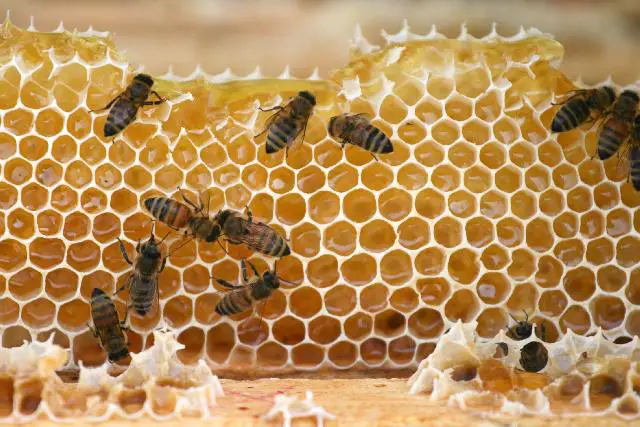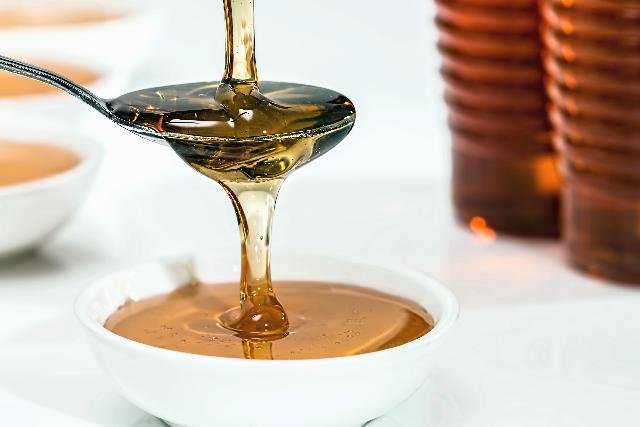Last Updated on August 6, 2023 By Emma W. Thomas
Honey belongs to the “sweets and sweeteners” food group. It is a natural sweetener obtained from bees and is commonly used to add flavor and sweetness to various dishes and beverages.
What Food Group Is Honey?
Honey is not only a delicious sweetener but also a versatile ingredient that is enjoyed all over the world. While it may be tempting to categorize honey as simply a sugary treat, it actually belongs to a specific food group. In fact, honey can be classified into multiple food groups based on its composition and nutritional properties. Here are five food groups that honey can be grouped under:
- Carbohydrates:
Honey is primarily composed of carbohydrates, making it an excellent source of quick energy. It contains natural sugars like fructose and glucose, which are easily digested and absorbed by the body. These carbohydrates provide the body with fuel, making honey a popular choice among athletes and those needing an energy boost. - Natural Sweeteners:
Due to its sweet taste, honey is often used as a natural sweetener. Compared to refined sugar, honey contains higher levels of natural sugars and is sweeter in taste. As a healthier alternative, it can be incorporated into various recipes, including desserts, beverages, and even savory dishes. - Antioxidants:
Honey is known for its antioxidant properties, which can help protect our bodies against oxidative stress and cell damage caused by free radicals. Antioxidants play a crucial role in maintaining overall health and reducing the risk of chronic diseases. Darker honey, such as buckwheat honey, tends to have higher antioxidant levels. - Natural Remedies:
For centuries, honey has been used as a natural remedy for various ailments. It is believed to possess antimicrobial properties, making it effective against certain bacteria. Honey can also soothe sore throats, ease coughs, and promote healing when applied topically to wounds. Its medicinal properties make honey an important member of the natural remedies food group. - Bee Products:
Honey is a byproduct of bees and is harvested from their honeycombs. In this sense, honey can be considered part of the bee products food group. Other examples of bee products include beeswax, royal jelly, and propolis. Each of these products has unique characteristics and benefits.
Benefits Of Honey

1. Rich in Antioxidants:
Honey is rich in antioxidants, including phenols, enzymes, and compounds like flavonoids and organic acids. Regular consumption of honey can help lower the risk of heart disease, stroke, and some types of cancer.
2. Nutrient-Rich:
Honey is a valuable source of nutrients such as vitamins and minerals. Among the vitamins found in honey are Vitamin C, calcium, and iron.
| Nutrients | Quantity |
|---|---|
| Vitamin C | 0.5 mg |
| Calcium | 6 mg |
| Iron | 0.42 mg |
3. Antifungal and Antibacterial Properties:
Honey has antifungal and antibacterial properties which means it can kill harmful bacteria and fungi. This makes it a great option for wound healing and treating ulcers.
4. Soothes a Sore Throat:
Honey is an age-old remedy for sore throat and cough. It can help reduce mucus secretion and coughs. Moreover, it’s delicious and can be added to tea or taken on its own.
5. Digestive Aid:
Honey helps in improving digestion by reducing constipation, bloating, and gas. Its antioxidant and antibacterial properties can improve digestive health.
6. Skincare Benefits:
Honey is an excellent skincare ingredient as it nourishes, hydrates, and brightens the skin. Its antibacterial property also helps in reducing acne.
7. Regulates Blood Sugar Levels:
While honey does contain simple sugars, it’s not the same as white sugar or artificial sweeteners. The particular combination of fructose and glucose in honey helps the body regulate blood sugar levels.
8. Sleep Promoter:
Consumption of honey promotes a night of restful sleep. Honey can cause a rise in insulin and release serotonin – a neurotransmitter that improves mood and happiness.
9. Boosts Memory and Concentration:
Honey is known to boost memory and concentration. It supplies the brain with the necessary glucose that boosts memory and concentration.
10. Weight Management:
Honey helps in weight management when used in moderation. Honey burns off more quickly than sugar and can contribute to weight loss as part of a balanced diet.
What Does Honey Contain?
Who would even think that the nectar from a flower would have all these nutritional values? Honey often falls under the umbrella group of carbs according to its nutritional profile. There are notions by netizens regarding the categorization of honey.
Even though Honey is actually a sweetener, it is highly rich in fructose, sucrose, glucose, and maltose. These are nothing but constituents of sugars. Small quantities of 18 amino acids are found in it too. The protein constituency in honey is only 0.3%. Vitamins B and C and minerals like magnesium selenium phosphorus, and zinc are prominent in honey. So you exactly know how helpful it can be for the body.
Fructose is found in fresh fruits naturally. And when one consumes the fruit, they get to have the fiber, vitamins, minerals, and phytonutrients. These can never be obtained from sugar alone.
Multi-Ingredient Foods Such As Candies And Biscuits Have High Honey Content.
| Carbohydrates in Honey | Average | Range | Standards |
|---|---|---|---|
| Fructose (%) Glucose (%) Reducing sugars (%) Sucrose (%) Fructose/Glucose Ratio | 38.38 30.31 76.65 1.31 1.23 | 30.91-44.26 22.89-40.75 61.39-83.72 0.25-7.57 0.76-1.86 | 1.77 03.04 02.76 00.87 00.126 |
Is It A Fruit Or A Vegetable?
The bees drink the nectar from a flower and process it internally. Through regurgitation, it goes into the hive cells, which they consume again and sticks into other cells, adding more enzymes in the process. They then dry it out and repeat the process until it is highly thick enough to be honey. It is a mix-up of fructose and glucose.
People often tend to confuse honey and sugar. Even though they are both sweet, they have different components. Sugar is made of sucrose, whose each molecule has one molecule of glucose and one molecule of fructose. So, sugar is 50% glucose and 50% fructose. Honey, however, consists of 35% glucose and 40% fructose. About 9% sucrose and other snakker amounts of some simpler carbs make up the rest of it.

Is Honey Healthy For Real?
Honey has innumerable health benefits. But having too much honey, like any carbohydrate-rich food, can increase the rate of glycated hemoglobin, which is the A1C, over time. If you have diabetes, the carbohydrate content can add to the changes in your medicine as well. The best is to ask for your physician’s help before taking in too much honey.
Normally honey is the best replacement for sugar. However, it is also a calorie-dense food. It can easily fit into a low-carb moderate diet in small amounts along with other nutritious food. Often it can add up to hundreds of calories without many realizations.
How Is Honey An Alternative To Sugar?
Have sugar cravings in the middle of the night and you don’t have ice cream or chocolates. Worry not. That little jar of honey can be your best friend tonight! The best way to have it is to add a layer to your favorite cookies, or simply apply it between two plain biscuits to make a sweet sandwich, and voila!
It can be an alternative to sugar. Even though honey is rich in fructose, it has quite low levels of glycemic. People with diabetes can actually have honey as keeping blood sugar levels under control is said to be one of honey’s specialties.
Conclusion
Honey does not fall categorically under any specific good group like a vegetable or fruit or meat. It is the nectar that the bees suck out of flowers and collect in their hives. So technically, it is the liquid that stays in the middle of a flower. Manufacturers label it as a honey blend if it contains anything other than what the bees have already collected.
It normally would go as a sweetener more than being labeled as any specific category of fruit or vegetable. It definitely has added benefits like healing a wound and acting as a disinfectant but that does not terminologically make it fall under the medicinal tag. So, with all the added benefits of honey and being the sweet substitute sugar with immense effects and usages, honey shall remain the perfect replacement for sugar.
Want a good weight loss, a fast-healed wound, or even glowing skin? Honey is your answer. That instant glow on the skin can be attained really fast if you add honey in place of your face wash for a day, or drink it down with some warm water. But it does not, however, make honey a dermatological product.
References:
https://honeybeehobbyist.com/honey-food-group/
https://www.honeysource.com/which-of-the-food-groups-does-honey-belong-to/
Emma is a graduate of Domestic Science or Family and Consumer Sciences (Home Economics) from the University of Wisconsin. She has 7 years of experience Working with the strategic section of BestBuy and now writing full-time for Homeeon.
From Managing the Home, Interiors, Cleaning, and Exteriors to Gardening and everything about Making A Home Liveable – is her passion and this Homeeon is the result of this.
Emma loves decorating her home with the best stuff found online. She cares about quality over anything and writes reviews about them here in Homeeon. Get in touch with her over Pinterest.
Keep reading her blogs.
